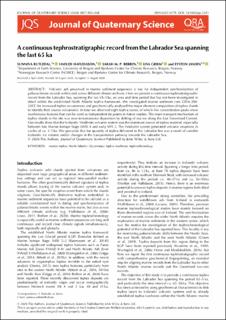| dc.contributor.author | Rutledal, Sunniva | |
| dc.contributor.author | Haflidason, Haflidi | |
| dc.contributor.author | Berben, Sarah Miche Patricia | |
| dc.contributor.author | Griem, Lisa | |
| dc.contributor.author | Jansen, Eystein | |
| dc.date.accessioned | 2021-05-20T13:22:51Z | |
| dc.date.available | 2021-05-20T13:22:51Z | |
| dc.date.created | 2020-12-11T15:07:53Z | |
| dc.date.issued | 2020 | |
| dc.identifier.citation | Journal of Quaternary Science. 2020, 35 (7), 855-868. | en_US |
| dc.identifier.issn | 0267-8179 | |
| dc.identifier.uri | https://hdl.handle.net/11250/2755920 | |
| dc.description.abstract | Volcanic ash preserved in marine sediment sequences is key for independent synchronization of palaeoclimate records within and across different climate archives. Here we present a continuous tephrostratigraphic record from the Labrador Sea, spanning the last 65–5 ka, an area and time period that has not been investigated in detail within the established North Atlantic tephra framework. We investigated marine sediment core GS16‐204‐22CC for increased tephra occurrences and geochemically analysed the major element composition of tephra shards to identify their source volcano(es). In total we observed eight tephra zones, of which five concentration peaks show isochronous features that can be used as independent tie‐points in future studies. The main transport mechanism of tephra shards to the site was near‐instantaneous deposition by drifting of sea ice along the East Greenland Current. Our results show that the Icelandic Veidivötn volcanic system was the dominant source of tephra material, especially between late Marine Isotope Stage (MIS) 4 and early MIS 3. The Veidivötn system generated volcanic eruptions in cycles of ca. 3–5 ka. We speculate that the quantity of tephra delivered to the Labrador Sea was a result of variable Icelandic ice volume and/or changes in the transportation pathway towards the Labrador Sea. | en_US |
| dc.language.iso | eng | en_US |
| dc.rights | Navngivelse 4.0 Internasjonal | * |
| dc.rights.uri | http://creativecommons.org/licenses/by/4.0/deed.no | * |
| dc.title | A continuous tephrostratigraphic record from the Labrador Sea spanning the last 65 ka | en_US |
| dc.type | Journal article | en_US |
| dc.type | Peer reviewed | en_US |
| dc.rights.holder | © 2020, Authors | |
| dc.description.version | publishedVersion | en_US |
| cristin.ispublished | true | |
| cristin.fulltext | original | |
| cristin.qualitycode | 2 | |
| dc.identifier.doi | 10.1002/jqs.3241 | |
| dc.identifier.cristin | 1858842 | |
| dc.source.journal | Journal of Quaternary Science | en_US |
| dc.source.volume | 35 | en_US |
| dc.source.issue | 7 | en_US |
| dc.source.pagenumber | 855-868 | en_US |
| dc.relation.project | Norges forskningsråd: 255415 | en_US |
| dc.relation.project | EC/FP7/610055 | en_US |

